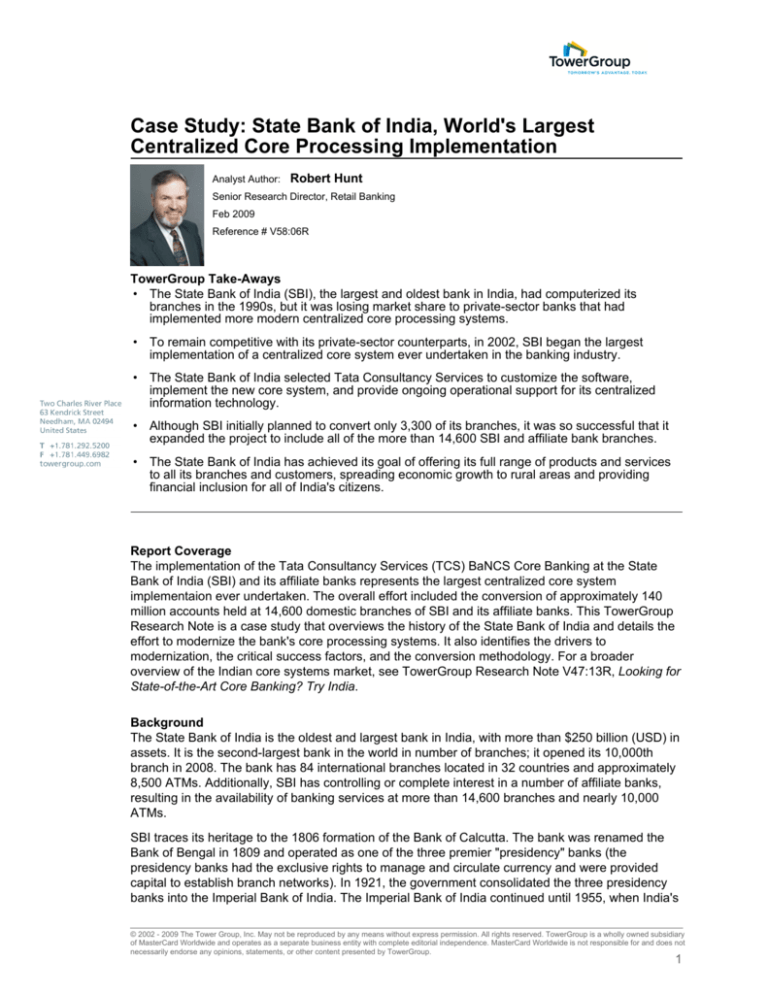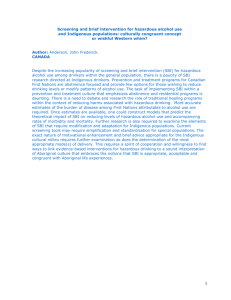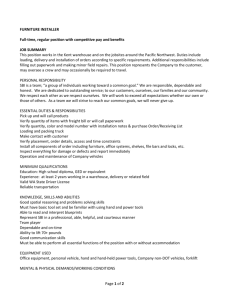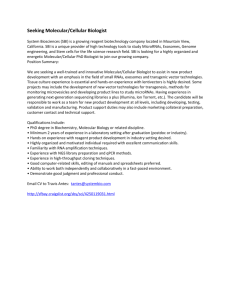
Case Study: State Bank of India, World's Largest
Centralized Core Processing Implementation
Analyst Author:
Robert Hunt
Senior Research Director, Retail Banking
Feb 2009
Reference # V58:06R
TowerGroup Take-Aways
• The State Bank of India (SBI), the largest and oldest bank in India, had computerized its
branches in the 1990s, but it was losing market share to private-sector banks that had
implemented more modern centralized core processing systems.
• To remain competitive with its private-sector counterparts, in 2002, SBI began the largest
implementation of a centralized core system ever undertaken in the banking industry.
• The State Bank of India selected Tata Consultancy Services to customize the software,
implement the new core system, and provide ongoing operational support for its centralized
information technology.
• Although SBI initially planned to convert only 3,300 of its branches, it was so successful that it
expanded the project to include all of the more than 14,600 SBI and affiliate bank branches.
• The State Bank of India has achieved its goal of offering its full range of products and services
to all its branches and customers, spreading economic growth to rural areas and providing
financial inclusion for all of India's citizens.
Report Coverage
The implementation of the Tata Consultancy Services (TCS) BaNCS Core Banking at the State
Bank of India (SBI) and its affiliate banks represents the largest centralized core system
implementaion ever undertaken. The overall effort included the conversion of approximately 140
million accounts held at 14,600 domestic branches of SBI and its affiliate banks. This TowerGroup
Research Note is a case study that overviews the history of the State Bank of India and details the
effort to modernize the bank's core processing systems. It also identifies the drivers to
modernization, the critical success factors, and the conversion methodology. For a broader
overview of the Indian core systems market, see TowerGroup Research Note V47:13R, Looking for
State-of-the-Art Core Banking? Try India.
Background
The State Bank of India is the oldest and largest bank in India, with more than $250 billion (USD) in
assets. It is the second-largest bank in the world in number of branches; it opened its 10,000th
branch in 2008. The bank has 84 international branches located in 32 countries and approximately
8,500 ATMs. Additionally, SBI has controlling or complete interest in a number of affiliate banks,
resulting in the availability of banking services at more than 14,600 branches and nearly 10,000
ATMs.
SBI traces its heritage to the 1806 formation of the Bank of Calcutta. The bank was renamed the
Bank of Bengal in 1809 and operated as one of the three premier "presidency" banks (the
presidency banks had the exclusive rights to manage and circulate currency and were provided
capital to establish branch networks). In 1921, the government consolidated the three presidency
banks into the Imperial Bank of India. The Imperial Bank of India continued until 1955, when India's
© 2002 - 2009 The Tower Group, Inc. May not be reproduced by any means without express permission. All rights reserved. TowerGroup is a wholly owned subsidiary
of MasterCard Worldwide and operates as a separate business entity with complete editorial independence. MasterCard Worldwide is not responsible for and does not
necessarily endorse any opinions, statements, or other content presented by TowerGroup.
1
central bank, the Reserve Bank of India, acquired the majority interest in the bank and changed its
name to the State Bank of India (SBI).
In 1959, the Indian government passed the State Bank of India Act, resulting in the acquisition
(majority shareholding) of eight state-affiliated banks and the creation of the State Bank of India
Group (SBI Group). The SBI itself is now majority owned by the Indian government, which
purchased the shares held by the Reserve Bank of India. The State Bank of India and its affiliate
banks are profiled in Exhibit 1.
Exhibit 1
Profile of the State Bank of India and Associate Banks (May 2008)
Source: State Bank of India Group
Unlike private-sector banks, SBI has a dual role of earning a profit and expanding banking services
to the population throughout India. Therefore, the bank built an extensive branch network in India
that included many branches in low-income rural areas that were unprofitable to the bank.
Nonetheless, the branches in these rural areas bought banking services to tens of millions of
Indians who otherwise would have lacked access to financial services. This tradition of "banking
inclusion" recently led India's Finance Minister P. Chidambaram to comment, "The State Bank of
India is owned by the people of India."
A lack of reliable communications and power (particularly in rural areas) hindered the
implementation of computerization at Indian banks throughout the 1970s and 1980s. During this
period, account information was typically maintained at the local branches with either semiautomated or manual ledger card processing. During the 1990s, the Indian economy began a
period of rapid growth as the country's low labor costs, intellectual capital, and improving
telecommunications technology allowed India to offer its commercial services on a global basis.
© 2002 - 2009 The Tower Group, Inc. May not be reproduced by any means without express permission. All rights reserved.
2
This growth was also aided by the government's decision to allow the creation of private-sector
banks (they had been nationalized in the 1960s). The private-sector banks, such as ICICI Bank and
HDFC Bank, altered the banking landscape in India. They implemented modern centralized core
banking systems and electronic delivery channels that allowed them to introduce new products and
provide greater convenience to customers. As a result, the private-sector banks attracted middleand upper-class customers at the expense of the public-sector banks. Additionally, foreign banks
such as Standard Chartered Bank and Citigroup used their advanced automation capabilities to
gain market share in the corporate and high-net-worth markets.
State Bank of India Core Systems Modernization
Drivers for a New Core System
SBI had undertaken a massive computerization effort in the 1990s to automate all of its branches,
implementing a highly customized version of Kindle Banking Systems' Bankmaster core banking
system (now owned by Misys). However, because of the bank's historic use of local processing and
the lack of reliable telecommunications in some areas, it deployed a distributed system with
operations located at each branch. Although the computerization improved the efficiency and
accuracy of the branches, the local implementation restricted customers' use to their local branches
and inhibited the introduction of new banking products and centralization of operations functions.
The local implementation prevented the bank from easily gaining a single view of corporate
accounts, and management lacked readily available information needed for decision making and
strategic planning.
The advantages in products and efficiency of the private-sector banks became increasing evident in
the late 1990s as SBI (and India's other public-sector banks) lost existing customers and could not
attract the rapidly growing middle market in India. In fact, this technology-savvy market segment
viewed the public-sector banks as technology laggards that could not meet their banking needs. As
a result, the Indian government sought to have the public-sector banks modernize their core
banking systems. In response to the competitive threats and entreaties from the government, SBI
engaged KPMG Peat Marwick (KPMG) in 2000 to develop a technology strategy and a
modernization road map for the bank.
In 2002, bank management approved the KPMG-recommended strategy for a new IT environment
that included the implementation of a new centralized core banking system. This effort would
encompass the largest 3,300 branches of the bank that were located in city and suburban areas.
The State Bank of India's objectives for its project to modernize core systems included:
• The delivery of new product capabilities to all customers, including those in rural areas
• The unification of processes across the bank to realize operational efficiencies and improve
customer service
• Provision of a single customer view of all accounts
• The ability to merge the affiliate banks into SBI
• Support for all SBI existing products
• Reduced customer wait times in branches
• Reversal of the customer attrition trend
Challenges for the Bank
The bank faced several extraordinary challenges in implementing a centralized core processing
system. These challenges included finding a new core system that could process approximately 75
million accounts daily — a number greater than any bank in the world was processing on a
centralized basis. Moreover, the bank lacked experience in implementing centralized systems, and
its large employee base took great pride in executing complex transactions on local in-branch
© 2002 - 2009 The Tower Group, Inc. May not be reproduced by any means without express permission. All rights reserved.
3
systems. This practice led some people to doubt that the employees would effectively use the new
system.
Another challenge was meeting SBI's unique product requirements that would require the bank to
make extensive modifications to a new core banking system. The products include gold deposits
(by weight), savings accounts with overdraft privileges, and an extraordinary number of passbook
savings accounts.
Vendor Consortium Selection
Recognizing the need for large-scale centralized systems expertise, SBI sought proposals from a
number of vendor consortiums that were headed by the leading systems integrators. From these
proposals, the bank narrowed down the potential solutions to vendor consortiums led by IBM and
TCS. The TCS group included Hewlett-Packard, Australia-based Financial Network Services
(FNS), and China Systems (for trade finance).
Although SBI favored the real-time processing architecture of FNS's BaNCS system over that of the
IBM consortium's memo post/batch update architecture, the bank had several concerns about the
TCS consortium proposal. They included the small size and relatively weak financial strength of
FNS (TCS would eventually purchase FNS in 2005) and the ability of the UNIX-based system to
meet the scalability requirements of the bank. Therefore, it was agreed that TCS would be
responsible for the required systems modifications and ongoing software maintenance for SBI.
Additionally, scalability tests were performed at HP's lab in Germany to verify that the system was
capable of meeting the bank's scalability requirements. These tests demonstrated the capability of
TCS BaNCS to support the processing requirements of 75 million accounts and 19 million daily
transactions.
Tata Consultancy Services and TCS BaNCs
Tata Consultancy Services, headquartered in Mumbai, India, is one of the world's largest
technology companies with particular expertise in systems integration and business process
outsourcing. The company has more than 130,000 employees located in 42 countries and achieved
revenues of $5.7 billion in fiscal 2008. Although TCS has long been a leader in core systems
integration services for banks, after it purchased FNS in 2005, the company also became a leading
global provider of core banking software for large banks.
The BaNCS system is based on service-oriented architecture (SOA) and is platform and database
independent. In addition to SBI, TCS BaNCS clients include the Bank of China (installation in
process), China Trust, Bank Negara Indonesia, India's Bank Maharashtra , National Commercial
Bank (Saudi Arabia), and Koram Bank (Korea).
TCS has also expanded its US footprint with the opening of its largest resource delivery center in
North America (near Cincinnati, Ohio) that can house 20,000 personnel. The company is seeking to
license and implement the BaNCS system in North America and recently completed a major part of
an effort to ensure that the BaNCS system meets US regulatory and compliance requirements.
Initial SBI Core Systems Modernization Project
The contract for the initial project was completed in May 2002; 3,300 branches were to be
converted by mid-2007. TCS immediately began a six-month gap analysis effort to determine the
required software changes to the BaNCS system. The changes included installing required
interfaces with more than 50 other systems as well as making enhancements to support the bank's
product requirements. These product requirements were separated by customer segment to allow
the vendor and bank to begin conversions before all the needed modifications were implemented.
They placed a priority on the needed changes that would allow branches with high-net-worth
individuals and then corporate accounts to be converted as soon as possible.
Before the first conversion in August 2003, TCS and HP created the data processing environment
for SBI. The primary data center was established on the outskirts of Mumbai and a backup center
© 2002 - 2009 The Tower Group, Inc. May not be reproduced by any means without express permission. All rights reserved.
4
was established approximately 1,000 miles to the east in Chennai. The centers were equipped with
HP Superdome servers and XP storage systems in a failover configuration utilizing HP's UNIX
operating platform.
Initial Conversion Project
The conversion effort began in August 2003, when SBI converted three pilot branches to the
BaNCS system. The successful conversion and operation of the pilot branches was followed by the
conversion of 350 retail branches with high-net-worth customers between August 2003 and
September 2004. At this point, the bank intentionally halted the conversions to analyze and resolve
reported problems. They analyzed, categorized, and prioritized these problems by type of
resolution (e.g., software, procedural, training) and severity. TCS managed software revisions for
the critical software changes while the branch personnel managed the needed training and
procedural changes.
After the software and procedural changes were implemented, SBI converted an additional 800
branches between December 2004 and March 2005. Unlike in the previous conversions, this group
of branches included predominantly commercially oriented offices. The conversion effort then
refocused on retail branches until November 2005, when the bank paused again to resolve
problems that came up during this second group of conversions.
After the second round of changes, the system and processes were functioning smoothly, and
management believed the branch conversion could be accelerated. An assembly line approach
was then employed in April 2006 to speed the branch conversion process:
• Branch personnel were responsible for data scrubbing and cleaning of their customer information
on the existing system.
• Branches were notified three months prior to their conversion date to begin "mock," or test,
conversions using a specially created test version of the BaNCS system.
• Branches performed several test conversions to ensure the actual conversion went smoothly.
As the new core banking system was rolled out across the SBI branches nationwide, a special
process was introduced in the nightly batch window to add the new branches. The process
increased batch processing time approximately 20 minutes and typically included adding branches
in groups of 50. This additional process, of course, was unnecessary upon completion of the rollout
and has since been removed from the nightly batch window. TCS and local area branch managers
oversaw the conversions, and the bank's circle (regional) heads formally reported the status to the
chairman's office.
By employing the assembly line approach for branch conversions, SBI was able to convert 1,200
branches in April and May 2006, completing the initial 3,300-branch conversion two months ahead
of the original schedule. The milestones for the initial core systems implementation project are
included in the SBI and affiliate banks core systems modernization time line in Exhibit 2.
© 2002 - 2009 The Tower Group, Inc. May not be reproduced by any means without express permission. All rights reserved.
5
Exhibit 2
Time Line of State Bank of India and Affiliate Banks' Core Systems Modernization (2000–09)
Source: Tata Consultancy Services (TCS)
Affiliate Banks' Conversion
As the rollout plans for State Bank of India were being finalized, the bank decided to extend the
scope of the core banking implementation to include its (then) eight affiliate banks. TCS created a
separate processing environment within the Mumbai data center used to support SBI.
The conversion effort for each of the affiliate banks spanned 18 to 24 months; the first six months
were used for planning, training, and establishing the processing environment for the banks. The
branch conversions overlapped among the banks, allowing all the affiliate banks to be converted in
30 months. The project was begun in July 2003 for the State Bank of Patiala and in 2004 for the
other affiliate banks. All of the affiliate bank branches were converted to the BaNCS system by the
end of 2005, as reflected in Exhibit 2.
State Bank of India Full Branch Conversion
The success of the initial 3,300-branch conversion for SBI demonstrated that:
• TCS had the technical capabilities to support the bank's IT initiative and scale of operations.
• Bank personnel had the skills to adopt new processes and support the conversions.
• The Indian customer base would react to new technology by adopting new electronic services and
demanding new, more sophisticated banking products.
• An assembly line approach could be used effectively to support large-scale branch conversions.
© 2002 - 2009 The Tower Group, Inc. May not be reproduced by any means without express permission. All rights reserved.
6
Given the success of the initial project and SBI's desire to offer new products to all of its customers,
a new IT plan was created that would encompass all branches. TCS and the bank would have to
demonstrate the capability to process 100 million accounts in a single processing environment.
TCS and HP then conducted another scalability test in September 2006 to determine if the system
could process SBI's entire base of 100 million accounts (excluding the affiliate banks, which use a
separate processing environment) with sustained peak online throughput of 1,500 transactions per
second. They conducted the test at HP Labs in Cupertino, California, using two 32-CPU HP 9000
Superdome application servers and two 32-processor Itanium Core HP Integrity servers for the
database. The test achieved a sustained peak real-time transaction rate of more than 1,575
transactions per second, meeting the projected processing demands of SBI. Additionally, batch
tests were run for both deposits and loan account processing. The month-end batch process for
loans required 1 hour and 5 minutes, and deposit processing was completed in 2 hours and 27
minutes. These benchmarks were audited by Ernst & Young, and the test results are highlighted in
Exhibit 3.
Exhibit 3
State Bank of India Scalability Test of TCS BaNCS System for Full Branch Conversion
Source: Tata Consultancy Services (TCS)
Based on the successful scalability test, SBI decided to convert the approximately 6,700 remaining
SBI branches to the BaNCS system. The conversion of the remaining branches began in June
2006, with the stated goal of completing the conversion by year-end 2008. Utilizing the assembly
line conversion approach established in the initial phase, the bank converted 1,400 of these
branches by March 2007.
© 2002 - 2009 The Tower Group, Inc. May not be reproduced by any means without express permission. All rights reserved.
7
Because the conversion methodology and BaNCS system were thoroughly proven and stable, the
assembly line conversion approach allowed the bank to complete the conversion ahead of
schedule. Between April 2007 and March 2008 (the bank's fiscal year end), SBI converted 4,600
branches to the new system. The remaining branches were converted between April and July 2008.
Critical Success Factors
Large-scale core systems implementations are typically the most costly and risky IT projects
undertaken by banks. Failures of core systems projects are not uncommon at large banks and
result in both financial impact and lost business opportunities. Further, failed projects lead other
banks to delay needed core systems replacements because they measure the risk of failure against
the potential benefits of a new system.
TowerGroup believes that several critical factors contributed to the success of the SBI core
implementation effort:
• Senior management commitment. The project was driven by the chairman of SBI, who met every
month with the information technology (IT) and the business sector heads. The chairman
monitored the overall status and ensured that sufficient resources were allocated to the
project. TCS senior managers were thoroughly committed to the project as well and periodically
met with the SBI chairman to review the project status.
• Staffing and empowerment of project team. The core banking team consisted of the bank's
managing director of IT acting as team head and 75 business and IT people selected by the bank.
TCS also staffed the project with approximately 300 IT professionals trained on the BaNCS
system. Importantly, the SBI business people were viewed not just as contributors to a key
project but as future bank leaders. This team reported to the SBI chairman and was empowered
with all decision-making authority.
• Ownership by business heads. The regional business line heads were responsible for the
success of conversion of their respective branches and reported the status to the chairman.
Thus, the business heads' objectives were aligned with those of the project team.
• Focus on training. SBI used its network of 58 training centers across India to train
employees on the new system. TCS personnel first educated approximately 100 SBI professional
trainers, who then trained 100,000 SBI employees at the centers; the remaining employees
trained at their respective job sites.
Benefits of New Core Systems Implementation
The new core system has resulted in benefits throughout the bank for both the customers and the
employees of SBI. For example, the new core banking system has allowed the bank to redesign
processes. It established 400 regional processing centers for all metro and urban branches that
have assumed functions previously performed in the individual branches. The bank recently
reported that business per employee increased by 250% over the last five years.
The bank has achieved its goal of offering its full range of products and services to its rural
branches. It delivers economic growth to the rural areas and offers financial inclusion for all of
India's citizens.
Implementation of the TCS BaNCS system has provided the bank with the ability to consolidate the
affiliate banks into SBI. In fact, the bank recently completed the consolidation of State Bank of
Saurashtra into SBI.
The bank has reversed the trend of customer attrition and is now gaining new market share.
Completion of the core conversion project has also allowed the bank to undertake several new
initiatives to further improve service and support future growth. These initiatives include the
deployment of more than 3,000 rural sales staff, redesign of over 2,200 branches in the last fiscal
year, opening of more than 1,000 new branches, establishment of a call center, and an active plan
© 2002 - 2009 The Tower Group, Inc. May not be reproduced by any means without express permission. All rights reserved.
8
to migrate customers to electronic delivery channels. The improvement in productivity and growth
of business for the SBI Group is reflected in Exhibit 4.
Exhibit 4
Selected Business Results for State Bank of India Group (2002–07)
Source: State Bank of India Group
Summary
The implementation of the Tata Consultancy Services (TCS) BaNCS system at the State Bank of
India (SBI) represents the largest core systems project ever undertaken. The success of this project
should encourage other large banks to begin projects to modernize their core systems.
The use of a UNIX-based platform to process more than 100 million accounts daily demonstrates
that tier 1 banks can use a mainframe alternative for their core processing. Although TowerGroup
expects that the majority of these banks will continue to rely on the IBM mainframe for core
processing, they can fully consider the benefits of utilizing a UNIX-based platform.
SBI's achievement demonstrates that attention to critical factors is crucial in implementing new core
systems. The bank's senior management commitment, business line involvement, project team
staffing and empowerment, and extensive employee training were all key contributors to the
success of the project. Management also recognized the need for a proven systems integrator that
possessed in-depth expertise in both business and technology.
Core systems modernization has allowed the State Bank of India to centralize computer processing
and operations functions, offer new banking products to all the citizens of India, reverse a trend of
customer attrition, and consolidate its affiliate banks. Additionally, the bank can now further expand
its product offerings and improve customer service.
© 2002 - 2009 The Tower Group, Inc. May not be reproduced by any means without express permission. All rights reserved.
9







